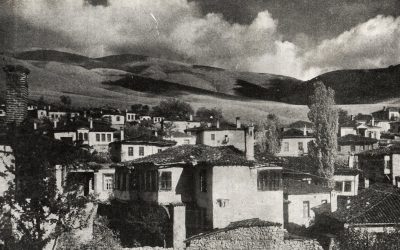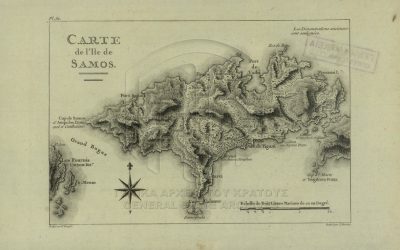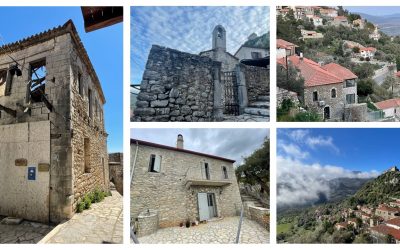By Giannis Michalakakos, MSc in Cultural Management
In order to fully understand the impact of the 1821 Revolution on Greek families, we have to understand life before, during and after the Revolution. Most of the examples discussed below focus on Lakonia, my homeland, while being broadly relevant at the same time.
Conditions Before 1821
The social conditions in Greece during the Ottoman rule were miserable in most places and for most people. The good conditions of social peace and tranquility were forgotten for centuries. Α feeling of insecurity dominated most Christian villages both on the islands and on the mainland. Stories explaining how families managed to survive during the Ottoman occupation are common in Greece and are of great interest; in fact, some of those which refer to small settlements can be confirmed through archival research. The widespread insecurity and unrest of the period had a heavy impact on the concentration of the population, the growth of dispersion, and of course in geography and the development of the settlements.
The depreciation of lowland and coastal settlements led to the economic and social development of mountainous areas. The village of Koumousta in Lakonia is a characteristic example. In late Byzantine times, Koumousta was a small fortress with a few houses and a small population, an outpost of the great castle of Mystras. However, in 1700 we see a big change in the character of the settlement, as it now numbered about 700 people (158 families). It had grown into an active and strongly populated community in the highlands of the Taygetos mountain. In order to feel more secure, to eliminate contact with the Ottomans and therefore to avoid any aggression from their part, the Christian population moved to mountainous and inaccessible places, invisible from the plains of Sparta, which the Turks controlled for economic reasons. Accordingly, in Mani, the complete absence of plains, combined with the warlike spirit of the people, led to tremendous population and urban development in the period before the Revolution of 1821.
Religious oppression was also significant. While Sultans may have granted certain privileges to some areas, there were serious limitations on the architecture of the temples, operating mode and even the attire of the enslaved Greeks. Steeple bells were forbidden to ring, while the height of the church bells had to be small. In general, the Ottoman Empire treated its Christian subjects as “second class citizens.” This is clearly indicated by the following two examples.
A letter from the people of Arna, Lakonia, to Governor Ioannis Kapodistrias in 1828 explains that back in 1778 one of the Drogkaris brothers who lived in Arna had converted to Islam. Soon later, he used some help from the local Ottoman authorities to displace his brothers from their father’s estate and keep it all for himself. His brothers and their descendants remained Christians and demanded justice 50 years later, in 1828, when Ottomans no longer controlled the Peloponnese. Another letter from the people of Rozova, Lakonia, to the Governor mentioned that in 1760 Ismail Spahis Karamanis, an Ottoman Albanian officer, had killed the village’s priest, Ioannis Kyriakakis, because the village bell had rung. The villagers ran to the church to see what happened. When they saw the dead priest and learnt what happened, they requested some explanation from the officer. They were then attacked by Karamanis who actually killed one more villager, Skordogiannis. In shock, the people abandoned their village for a while, and Karamanis took control of most of the village.
Economic pressure was another important issue for the Christian population of the Ottoman Empire. The “haraç” was a land tax levied on non-Muslims only, while the “tax of the blood” occasionally obliged Christian families to send a boy to serve in the Ottoman military and join the Janissary troops which rocked Europe in the 16th century. For Greek families, that was a tremendous obstacle to family cohesion as many of the boys converted to Islam and cut bonds with their families. The situation was similar for girls. They were kidnapped and transferred to the harems of local “pashas” (officers). Forced loan agreements were yet another tool of Ottomans to exploit poor Greek families. Low-ranked Ottoman officers forced Christians to sign repayment bills for short periods of time. In case Christians could not repay, the Ottomans would take their possessions. In 1775, for instance, a Muslim officer in charge of Albanian mercenaries forced villagers of Palaiochori (near Koumousta) to sign a repayment bill for the “protection” offered to them. Despite their best efforts, the villagers failed to repay the loan on time. Soon, the officer went to the village and killed the local Christian leader, Ioannis Vigas. Like the people of Rozova in 1760, most villagers abandoned Palaiochori and fled to Mani, where Ottoman control was weak.

Conditions During the Revolution
Ottoman pressure on the Greek Christian population created a desire for freedom and national independence. The thirst for better life conditions had often led to rebellions which all failed due to the bad organization and poor means of the rebels. The repercussions of these attempts were catastrophic. However, things would change for good in 1821.
Ottoman armed forces did not have bases in many areas. In Mani, for instance, there was a complete absence of Ottoman troops. For this reason, together with its experienced manpower, Mani was conducive for the concentration of a considerable number of rebels. In other areas, families had decided to gather enough supplies and equipment and create local centers of resistance. As communication was not easy, everything had to be accurately organized. On March 23rd 1821, Petros Mavromichalis, chieftain of Mani, conquered Kalamata with an army of 2,000 men from Mani. This was the first town to be liberated by the revolutionaries. Capturing a city was a great accomplishment for the Greeks, who then declared their independence! Having Kalamata as their base, warlords, such as Kolokotronis, Nikitaras, Anagnostaras and Papaflessas, went to their provinces to spread the seeds of revolution.
After the military successes of the first months of the Revolution, more and more Greeks who were initially hesitant contributed to the fight. The islands entered the fight in April. By September 1821, all of Southern Greece was at war, with the capture of Tripolis, the administrative center of the Peloponnese, being the most important success. By the end of the year, most Peloponnesian fortresses were either occupied or under siege. Problems, however, did not take long to arise. The rebels were not a trained army under the command of one single general, but a group of exasperated people. Some fought for religious freedom, some for statehood, some for social rights, and some simply for looting. Conflicting interests caused harsh confrontations. On the contrary, the Ottoman Empire had extensive war-experienced personnel both on land and at sea. After the defeat of Ali Pasha and his execution by the Sultan’s troops, the Empire could focus entirely on the Greek uprising.
Terrorism was a key measure of dealing with the Revolution. The massacre of island populations in conjunction with the campaign of 30,000 men under Dramali Pasha in the Peloponnese brought tremendous demographic upheavals throughout Greece. The massacre of Chios is a typical example: most of the population was murdered, with the rest being sold in the slave markets of Egypt and the Middle East. The few surviving families found shelter on other islands and in the Peloponnese. The surname “Chios/Chiotis”, which is found all over Lakonia, was used by such refugees to indicate their origin. Nevertheless, none of these destructive measures was sufficient to break the Greek Revolution.
As Ottoman troops were proving incapable of dominating the Peloponnese, in 1825, the Sultan called the Pasha of Egypt for help. The Pasha’s son, Ibrahim, arrived to the Peloponnese with an army trained by French officers who had fled to Egypt after the fall of Napoleon. Ibrahim’s arrival brought great political, military and social unrest. After he easily won some battles in Messinia, he began to destroy everything in his path, in order to break the spirit of the Revolution. Fear and terror returned to the hearts of Greek families, as the war now seemed uncertain.
The cost was quite heavy for Lakonia. With the exception of the area of Mani, where he was defeated three times, Ibrahim raided Lakonian villages burning them down, massacring and enslaving their population. In 1825 and 1826, villages like Vrontamas, Geraki, Vlachiotis, Kremasti, Levetsova (Krokees) and Apidia saw the cruel face of slavery and destruction.
Ibrahim’s atrocities, the massacres in Chios and Psara, together with romantic Western perceptions of Greekness and its ancient heritage, resulted in the creation of an international movement of sympathy towards the Greek cause. Philhellenes, sympathizers from various parts of the world, arrived to Greece to provide military and financial assistance. This movement affected public opinion in Europe. The shift of British policy in the Greek issue dragged other powerful empires, France and Russia, to end the domination of the Ottoman Empire in the Mediterranean. As a result, in the naval battle of Navarino in 1827, the Turkish fleet met absolute catastrophe. In 1828, an army of 15,000 French under General Maison arrived in the Peloponnese to eliminate remaining Ottoman forces.
Read the story of Aikaterini Kanelli and find out more about Ibrahim’s Lakonian captives!
Conditions in the post-Revolution Era
The Greek State chose its leader before it was even recognized and declared independence, while fighting was still raging in the countryside. Former Foreign Minister of the Russian Empire, Ioannis Kapodistrias, a native of Corfu, was considered most appropriate for the position. In January 1828, he arrived toNafplio. His reform project aimed at creating an organized state from scratch. This was not an easy goal to achieve, as the war was still raging, financial resources were scarce, and chaos dominated. Still, Governor Kapodistrias started his program by centralizing the administration, organizing education, reorganizing the army, systematizing care for orphans and widows of the war, setting fair taxation and establishing courts. Nonetheless, the notables and old aristocracy of the liberated lands stubbornly refused to accept the reforms, realizing they were about to lose past privileges and influence, despite their contributions to the Revolution. As a result, the Governor was murdered in 1831, and the Great Powers decided to establish monarchy in Greece, sending Prince Otto of Bavaria and a regency council to govern in his name until he would be of age.
The early years of Otto’s reign were the backbone of the social developments that followed. Administrational, educational and military reforms continued. Local elders were replaced by mayors; schools were established in all municipalities of the country; irregular troops were disbanded and replaced by Bavarian officers and troops. While many of the reforms were positive, social unrest was not soothed. People demanded civil and social rights, tax relief and removal of the Bavarians who were often regarded as the new foreign rulers of the country. Uprisings broke out in Mani and Messinia (1834), in Akarnania, in Nafplio, Syros and Kythnos (1862). The most important one was that of Athens in 1843, which resulted in a Constitution and the end of absolute monarchy.
Despite local uprisings and administrative problems, the population of Greece, especially that of cities, had a new sense of freedom and safety, which changed people’s lives in many ways. The town of Sparta is a typical example. The absence of danger, combined with Philhellenic romanticism, led to the foundation of the modern town, planned in 1834 by Bavarian geometer Stauffert. With Sparta’s foundation, the population of the suburbs of Mystras moved to a brand new town in the valley, making it the capital of the prefecture. The villages of Koumousta and Xirokampi are other examples of population movements. As was previously mentioned, Koumousta, a mountainous -therefore safe- village, had a big population during the Ottoman period. On the contrary, Xirokampi, a village in the Spartan plain controlled by the Ottomans, was such a small settlement that it was not even included in the first census of the Greek state in 1828. However, after Greece’s liberation, things changed. The population of Koumousta started decreasing year by year, while that of Xirokampi started increasing, as the population of Koumousta started moving to the plain, which was now safe. In 1845, Xirokampi became the capital of the Faridos Municipality. By 1889, it numbered 895 residents, while Koumousta had only 145.
If you have ancestors from Xirokampi or Koumousta, you may want to check out Greek Ancestry’s Lakonian database!
Stability was restored at sea, as well. The strict laws against piracy imposed by Kapodistrias brought safety. People left mountainous villages and moved to the seashores. This resulted in the growth of trade, shipping and business. Local economy was developed, as the population increased. Originally known as Marathonisi, Gytheio was a small port during Ottoman times, mainly operated by the Grigorakis clan and its branches. After 1830, this family and its allies took advantage of the port’s position, and, as a result, Gytheio became the capital of Eastern Mani. A great deal of poor Inner Mani’s population started moving to the area of Gytheio, which was more fertile and accessible.
Last but not least, two more developments will be briefly mentioned. The first one was the state’s initiative (1830-1860) to reward and compensate fighters of the Revolution. As many fighters had lost all their money and fortune during the struggle, they could not support themselves without help. For this reason, the government decided to integrate some of the fighters into the army as officers, and to provide others with national lands which previously belonged to the Ottomans. With these measures came a great dispersion of families. For instance, Cretan families settled in Nafplio, Maniots settled in Messinia and Eastern Lakonia, Souliotes in Messinia and Chiots in Lakonia. At the same time, some of Muslims living in the territory of the new Greek state asked to be baptized Christians, in order to ensure their fortunes and not be bothered by the new government. These converts were known as “Neofotisti” (Newly-Enlightened).
[This is a shortened version of a presentation given by Giannis Michalakakos in the Hellenic Genealogy Conference of Salt Lake City, UT, in 2015. To access the whole presentation, visit this page. The article’s featured image, an 1821 revolutionary flag, comes from the website of the National Historical Museum: https://www.nhmuseum.gr/el/sylloges/sylloges/simaies/.]



